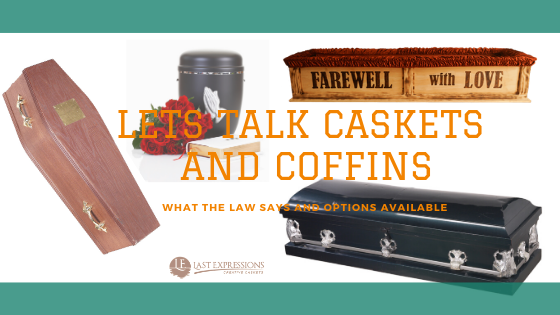Let's talk about Caskets and Coffins
There have been many thoughts passed on to me about people’s preconceived ideas on what they will be buried in. Often I am told ‘I don’t want a coffin’, or ‘just put me in a cardboard box’, or ‘I just want a shroud’, or ‘I don’t care I’ll be dead’.
As the law in Australia stands at this moment in time, everyone needs a coffin or casket to have their body transported anywhere. Whether you are buried or cremated in one is another matter.
The vessel that you are buried in needs at least some thought, for the benefit of the family that you leave behind. Because we as a collective have come to the point of avoiding any thought of dying, we are leaving all the important decisions about our funeral to our loved ones, at a time when they themselves are going through one of the most difficult emotions in their lives – grief.
Let’s look at coffins and caskets. The difference between the two is the shape – coffins are diamond shaped and caskets are rectangular. Also, coffins come with a hinged lid. Whichever vessel you choose, it must be of the appropriate size to fit your body. There is an Australian standard size casket, but as we look around, there is not really a standard size person anymore. For burial, particularly in overcrowded cemeteries, as close to the standard size is preferred. But, out of sheer respect for the dead person, we would want them to be comfortably laid out in their final resting place.
Although there are some minor differences from State to State within Australia, there are basic requirements for a coffin:
It must be sturdy enough to hold your weight. Nobody wants the bottom to fall out of their casket and although there is no official test to be passed, rigorous research into this is done by coffin makers. There’s a myriad of options available now including wicker, cardboard, MDF, pine, and even poly tube.
And leakproof. To ensure your casket is leak proof they are usually lined with plastic, underneath the fancy lining. Sometimes they also have shredded paper underneath the lining.
Another part of the decision process is whether you want to be buried or cremated.
Being cremated has a couple of other point of consideration.
Your casket MUST have a flat bottom. When being rolled into the cremator there must be no reason that the casket could get stuck. There are only 2 crematoriums in Victoria that will cremate bodies in a shroud alone.
The metal handles on a casket are removed before cremation purely because under severe heat they can warp and pop off, damaging the walls of the cremator.
Cardboard coffins are not recommended for cremation – they produce too much ash and do not generate heat. The ashes from remains burnt in a cardboard coffin can be 50% more than in a timber coffin. Once again there is a standard sized urn for ashes – which means the family could be presented with one and half urns for your remains.
So I hope this has given you some indication of why it is important to think about what type of casket or coffin you would prefer.
Jennie Barnes

